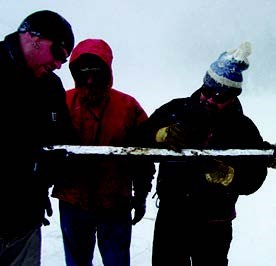Last updated: November 8, 2022
Article
Fire History and Climate Change

The Question: What can the fire and vegetation history of Rocky Mountain National Park tell us about Holocene (the last ten thousand years) climate and climate change?
Scientists know that fire frequency and intensity are related to ambient climatic conditions such as air temperature and humidity. However, do prehistoric archeological records show a relationship between fire occurrences, vegetative cover, and climate conditions over time?The Project: Using cores taken from the sediments of Bear Lake, scientists compared the fire and vegetative history of the area with radiocarbon dates of the various strata.
Because prehistoric climate data aren’t available, scientists depend on “proxy” indicators of weather to document past climatic conditions. In the present study, Dr. Jim Doerner of the University of Northern Colorado collected sediment cores from Bear Lake and analyzed the various strata, or layers, for radiocarbon age and the two climate indicators: (1) pollen, and (2) charcoal size and abundance.Radiocarbon analysis reveals the age of the various strata and provides the chronological background to compare pollen and charcoal data from the same strata. Microscopic examination of pollen samples reveals the dominant vegetation present at a particular time. Climatological conditions of that time can be inferred from reconstructing vegetation composition. Although charcoal is deposited throughout the core, scientists can differentiate increased local deposition from recent, nearby fires by measuring charcoal particles and statistically analyzing the particle size distribution and correlating these with the radiocarbon dates. Bigger and more numerous charcoal particles indicate the fire was closer to Bear Lake.
The Results: Climate plays a significant role in the area’s vegetation and the frequency and intensity of fire reflects the changing climate regimes.
The longest core was 255 cm (100 inches) long. Radiocarbon aging of the core layers revealed an age of approximately 6,100 Before Present (BP) for the lowermost layers. Twenty-eight kinds of plant pollen were found in the core. Tree pollen was dominant, averaging 75% and increased with depth or age of the core. Pine was the dominant tree species present (averaging 61% of the total tree pollen) followed by lesser amounts of spruce (8%). Pine pollen remained fairly constant throughout the core but spruce increased with depth. Oak pollen composed about 4% of tree pollen during 2,000 to 500 BP. Sagebrush pollen averaged 12% of the total pollen and decreased with depth. The pollen data indicates that climate was warmer than the present between 6,100 and 3,200 BP. Conditions cooled between 3,200 and 1,900 BP before warming conditions returned.The charcoal analyses showed that fires have occurred in the Bear Lake area at a rate of about two to five fires every 1,000 years over the past 6,100 years BP. Three main trends are shown by the charcoal records: (1) moderate to high fire activity in the last 1,900 years, (2) low to moderate fire activity in the period between 3,200 and 1,900, BP, and (3) increased fire activity during the early-middle Holocene (6,100-5,700 BP).
In summary, the Bear Lake pollen studies show that fires were more frequent during the warmer middle Holocene. Cooler, drier conditions and decreased fire activity characterized the transition from the middle to the late Holocene, with temperatures likely warmer than they are now. The climate cooled into the late Holocene, but later returned to a warming trend and increased fire activity. These findings provide new information about the natural processes that have shaped the landscape we see today and can help infer ecosystem response to climate change. Obviously, climate plays a significant role in the long-term fire history of the park, with increased fire activity during warmer periods and less fire activity during cooler periods.
This summary is based on published, peer-reviewed and/or unpublished reports available at the time of writing. It is not intended as a statement of park policy or as a definitive account of research results. Ages are given in radiocarbon years before present. For more information on the park’s research program, see www.nps.gov/romo Written by: Bert Cushing. Date: 05/01/2008. Photo credits: B. Butler.
